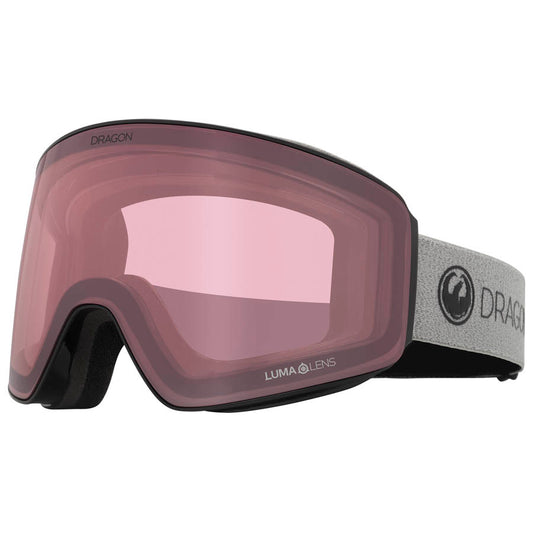Arguably one of the most vital pieces of equipment you will own is your ski goggles. Ask any skier and they will tell you that poor visibility on the mountain is about as bad as an ill-fitting pair of boots. All goggles are going to offer you some level of protection from the elements, but there are plenty of features that you may not be aware of or understand the importance of. This guide will offer you all the information you need and with the sections below you use it in tandem with our site filters to find the goggles that are perfect for you.

For boys, girls, and youth of all ages, as well as for adults with smaller faces.
Medium sized frames are going to fit most riders. Medium frames have average depth, width, and height.
For riders with larger faces or if you are seeking a larger size for increased field of vision. Large frames are very wide, tall, and deep.
To accommodate riders with glasses who choose to wear their glasses under their goggles. Over the Glasses, or OTG goggles, are a much less expensive option than a goggle that has your custom prescription. They are deeper than regular goggles and feature channels for the arms of your glasses.

When light reflects off of certain surfaces, it often reflects back at higher intensity through angles perpendicular to the surface. Polarized lenses will reduce this higher intensity reflection. In doing so, polarized lenses are lessening the strain on your eyes and reducing fatigue.

These lenses are designed to automatically adjust to lighting conditions. They will darken when exposed to stronger UV light and lighten when there is less. This makes them extremely versatile because they can provide greater visibility as conditions change. Unfortunately, Photocromatic lenses do not adjust instantaneously and it can take several minutes for them to fully adjust.

Mirrored lenses use a coating on the outside of the goggle lens to reflect more light than that of non-mirrored lenses. This makes them ideal for bright light conditions since they will allow less light through. Plus you get that awesome Robocop look.

Non-mirrored lenses do not have reflective capabilities like the mirrored style we discussed above. This means that they will allow more light to filter through. Therefore non-mirrored lenses are recommended for low or flat light conditions like overcast or night time skiing.
The three lens styles that you will come across are Spherical, Flat (Cylindrical), and Toric. Your lens shape may have an impact on your overall field of vision and peripheral vision while riding.

Goggles that have a shape that follows the curvature of your brow and provide a less distorted field of vision. They give your goggles a bubbled look, but beyond that, they offer better peripheral vision, less fogging, less distortion, and Read more

Also called Flat Lens, goggles that curve horizontally (compared to spherical ones which curve both horizontally and vertically). They may offer a more limited field of vision and may have some added glare versus spherical lenses, but can be a Read more

Goggles that give you the best of both worlds that we described above. Toric lenses have slightly less curvature side-to-side, but a true spherical curve top to bottom. This shape follows the shape of your face more closely resulting in Read more

As we have outlined in this guide, there isn’t one singular goggle lens that is capable of providing optimal visibility across all of the different lighting conditions. There is, however, a lens offered for just about every light condition. Manufacturers use what is known as the Visual Light Transmission, or VLT. The VLT is a percentage scale that refers to how much light is entering the lens. The scale runs from 0% to 100% and the higher the percentage, the more light is entering, the lower the percentage, the less light is entering.
Low light conditions, such as snowy, foggy, or flat light conditions, you will want a higher VLT. These lenses will fall in the range of 60-90% VLT. Lens colors you will typically come across are yellow, rose, and blue.
High visibility conditions, such as sunny days, you will want a lens that keeps the light out. The VLT for lenses suited for these conditions is 5-20%. Lens colors you will typically come across are black, gray, gold, and they are often mirrored.
Polarized: When light reflects off of certain surfaces, it often reflects back at higher intensity through angles perpendicular to the surface. Polarized lenses will reduce this higher intensity reflection. In doing so, polarized lenses are lessening the strain on your eyes and reducing fatigue.
Photocromatic: These lenses are designed to automatically adjust to lighting conditions. They will darken when exposed to stronger UV light and lighten when there is less. This makes them extremely versatile because they can provide greater visibility as conditions change. Unfortunately, Photocromatic lenses do not adjust instantaneously and it can take several minutes for them to fully adjust.




| Most all quality snow goggles will feature a vent of some type, but it is important to know that some will be better than others. As a general rule, more venting is better to prevent fogging from occurring and proper ventilation is what helps to control the climate inside of your goggles. Each brand is going to feature something different. Because every brand is going to be different from the next, it is important to check that the venting system is compatible with your helmet. In short, don’t block the vents or your goggles will be more likely to fog. |




Designed for small faces of boys, girls, and youth of all ages. Simple, inexpensive lenses, but very durable.



